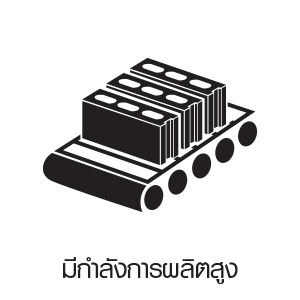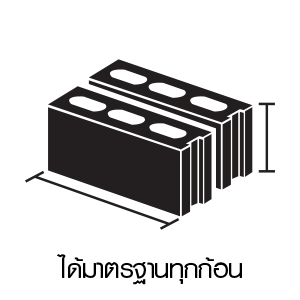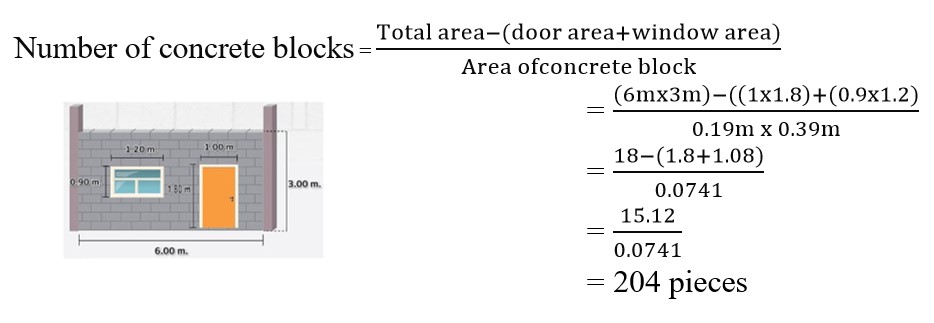-
Call Us
-
Email Us
-
Global Certificate
ISO 14001:2015
- เข้าสู่ระบบ
คอนกรีตบล็อกเชิงตันไม่รับน้ำหนัก 7 ซม.
Reference : P04-0012
| คอนกรีตบล็อกเชิงตันไม่รับน้ำหนัก 7 ซม. คัดวัตถุดิบที่มีคุณภาพได้มาตรฐาน มีเครื่องจักรที่มีมาตรฐานและควบคุมโดยช่างชำนาญการ เพื่อประสิทธิภาพของคอนกรีตบล็อกเชิงตันไม่รับน้ำหนักทุกก้อนใช้งานง่าย มีความแกร่ง พื้นผิวอิฐเรียบแต่ไม่ลื่น รูปเหลี่ยมคมชัดเจน ก่อง่าย ฉาบไว |
| Concrete blocks are made from high-quality, standard-compliant raw materials using advanced machinery, supervised by skilled technicians to ensure the efficiency of each block. They are easy to use, strong, and feature smooth but non-slippery surfaces with sharp, well-defined edges. This makes them easy to stack and quick to plaster. |
| คอนกรีตบล็อกเชิงตันไม่รับน้ำหนัก 7 ซม. มอก.2895 |
| เป็นคอนกรีตบล็อกตันที่ออกแบบมาสำหรับผนังที่ไม่รับน้ำหนักบรรทุก นอกจากน้ำหนักตัวเอง แต่เป็นวัสดุมีความแข็งแกร่งกว่าคอนกรีตบล็อกกลวงแบบทั่วไป ก่อได้พื้นที่มากโดยไม่ต้องใช้เสาเอ็นทับหลัง ลดเวลาในการก่อสร้าง เหมาะสำหรับงานก่อสร้างที่ต้องการความแข็งแรงและปลอดภัย การันตีคุณภาพด้วยเครื่องหมาย มอก. 2895-2561 |
| Non-load-bearing Solid Concrete Block 7 cm, TIS 2895 |
| This solid concrete block is designed for walls that do not bear loads other than their own weight. It is stronger than standard hollow concrete blocks and allows for larger areas to be constructed without the need for lintels or columns, thus reducing construction time. Ideal for projects requiring strength and safety, it is certified by the TIS 2895-2561 standard, ensuring its quality. |
| รายละเอียดสินค้า | |
| ขนาดมาตรฐานสูงxยาวxหนา (ซม.) | 19x39x7 เซนติเมตร |
| น้ำหนัก (กก./ก้อน) | 10.5 กิโกกรัม/ก้อน |
| ขนาดบรรจุ (ก้อน/พาเลต) | 204 ก้อน/พาเลต |
| น้ำหนัก/พาเลต (ตัน) | 2.14 ต้น |
| ขนาดพาเลตไม้ (เมตร) | 1.20x1.20 เมตร |
| ความต้านทานแรงอัดเฉลี่ย มาตรฐานมอก. 2895-2561 (MPa.) | ไม่น้อยกว่า 3.45 MPa. |
| ปริมาณการใช้งาน (ก้อน/ตร.ม.) | 14 ก้อน/ตารางเมตร |
| คุณสมบัติเด่น |
• รูปทรงและขนาดได้มาตรฐานทุกก้อน ผิวเรียบ เหลี่ยมคม เข้ารูปทุกก้อน ก่อง่าย ฉาบไว ประหยัดเวลา Properties of Solid non-loading bearing concrete blocks • Each block is uniformly shaped and sized, with smooth surfaces and sharp edges, making them easy to stack and plaster, saving time on construction. |

| 
| 
| 
|
| สำหรับการคำนวณ ปริมาณคอนกรีตบล็อกที่ต้องใช้ คิดจากสูตร จำนวนอิฐบล็อก(ก้อน)=พ.ท.ทั้งหมด(m)/พ.ท.อิฐบล็อก 1 ก้อน (m) |
 |
| Calculation The formula below to calculate the number of concrete block. |
 |
| กรณีมีหน้าต่างและประตู |
 |
| Case: There is a door and a window. |
 |
| “กระบวนการผลิต คอนกรีตบล็อกเชิงตันไม่รับน้ำหนัก 7 ซม.” (Process of making concrete blocks) |
กระบวนการผสม : |
| Mixing: |
| All raw materials will be qualified by the manufacturer to ensure the quality of raw material before they are used in production. This process starts by gathering all raw materials like stone dust and cement. A conveyor belt helps transfer the raw material to the weighing section to measure exact amounts of all materials by using a PLC (PLC is Programmable Logic Controller). The calibration intervals of these controllers are quarterly. Once the process of weighing is complete the process of mixing begins, where all the ingredients are blended together. The blending process is short after which water is added to the mixer. |
| กระบวนการอัดขึ้นรูป: |
| หลังจากผสมเสร็จเรียบร้อยแล้วเครื่องจะทำการปล่อยคอนกรีตเข้าสู่กระบวนการอัดขึ้นรูปคอนกรีตบล็อก เครื่องทำการเขย่าคอนกรีตให้เต็มแบบพิมพ์ จากนั้นเครื่องจะทำการอัดคอนกรีตบล็อกด้วยระบบไฮดรอลิกท์ที่มีกำลังอัดสูงเพื่อให้ได้คอนกรีตบล็อกที่มีคุณภาพตามที่กำหนดและเป็นไปตามมาตรฐาน มอก. จากนั้นคอนกรีตบล็อกผ่านเข้าสู่กระบวนการตรวจสอบคุณภาพเบื้องต้นในระหว่างการผลิต เมื่อผ่านการตรวจสอบเรียบร้อยแล้วคอนกรีตบล็อกจะถูกลำเลียงไปเข้าชั้นวางสำหรับยกคอนกรีตบล็อกเข้าสู่กระบวนการบ่ม |
| Molding: |
| After mixing, the concrete gats poured into molds. The concrete is compacted with high frequency vibration. After the mold is filled with concrete, the hydraulic press compresses the concrete in the mold. The result is high quality concrete blocks. These concrete blocks should meet Thailand Industrial Standard TIS No. 58-2560. Then, these concrete blocks moves to quality control process. After the quality control, the concrete blocks are pushed out of the mold onto a flat steel pallet for moving to curing process. |
| กระบวนการบ่มคอนกรีตบล็อก: |
| เมื่อคอนกรีตบล็อกถูกยกเข้าจัดเรียงในชั้นวางคอนกรีตบล็อกเต็มแล้วเครื่องจะทำการลำเลียงคอนกรีตบล็อกเข้าสู่โรงบ่ม โดยคอนกรีตบล็อกได้รับการบ่มเป็นเวลา 24 ชั่วโมงเพื่อป้องกันการแตกร้าวและให้ได้กำลังอัดตามมาตรฐาน มอก. |
| Curing: |
| Pallets of blocks are conveyed to an automated stacker and placed on a curing rack. Once the rack is full a set of rails is formed for moving into a curing area. Blocks remain in curing area for up to 24 hours at room temperature to prevent cracking and to ensure high strength. The process followed are in line with Thailand Industrial Standard. |
| กระบวนการแพ็คกิ้ง: |
| หลังจากคอนกรีตบล็อกผ่านการบ่มเป็นเวลา 24 ชั่วโมงแล้ว จะมีการเก็บตัวอย่างคอนกรีตบล็อกไปทำการทดสอบตามมาตรฐาน มอก . เมื่อคอนกรีตบล็อกผ่านการทดสอบเรียบร้อยแล้วเครื่องจะทำการยกคอนกรีตบล็อกเข้าสู่กระบวนการแพ็คกิ้ง คอนกรีตบล็อกจะถูกลำเลียงเข้าจัดเรียงในพาเลทโดยเครื่องจักรจะทำการจัดเรียงคอนกรีตบล็อกแต่ละขนาดตามจำนวนที่กำหนด ในระหว่างการจัดเรียงจะมีพนักงานคอยตรวจสอบคุณลักษณะเบื้องต้นของคอนกรีตบล็อกเพื่อให้คอนกรีตบล็อกที่จัดเรียงเข้าพาเลทเป็นไปตามมาตรฐานที่กำหนด เมื่อครบตามจำนวนที่กำหนดเครื่องจะทำการลำเลียงคอนกรีตบล็อกไปยังเครื่องห่อฟิล์มยืดเพื่อป้องกันน้ำและฝุ่น จากนั้นพนักงานจะทำการติด QR.Codeซึ่งแสดง ประเภท ขนาด จำนวน โรงงานผลิต กะที่ผลิต และวันเวลาผลิต จากนั้นเครื่องจะลำเลียงคอนกรีตบล็อกเพื่อยกเข้าจัดเก็บในกองสต๊อก คอนกรีตบล็อกจะทำการบ่มต่ออีกเป็นเวลา 6 วันก่อนส่งให้กับลูกค้า |
| Packing: |
| After the curing for 24 hrs, the quality control employee takes a sample to test. The process follows by Thailand Industrial Standards. After quality control is passed, the concrete blocks are moved to the packing process. The machine arranges quantity of concrete blocks of each size. At this moment, the production worker inspects the characteristics of concrete blocks to meet Thailand Industrial Standard. The concrete blocks are moved to a plastic wrap machine for covering to prevent water and dust. In addition, there are QR codes attached on each pallet to display information such as type of concrete blocks, dimension, pcs per pallet, date, and production time. Then, the concrete blocks can be moved to the stockyard. After 6 days the concrete blocks can be transported to customer. |
| การตรวจสอบคุณภาพ |
คอนกรีตบล็อกที่ |

| การทดสอบคุณภาพ |
| 1. การทดสอบความต้านทานแรงอัด |
| คือ การทดสอบความสามารถในการรับแรงอัดของคอนกรีตบล็อกว่าสามารถรับได้มากน้อยพียงใด การเตรียมตัวอย่าง ขั้นตอนการเตรียมตัวอย่างมัวิธีการดังต่อไปนี้ การดูลักษณะทั่วไปก็คืออิฐบล็อกทุกก้อนจะต้องไม่มีรอยแตกร้าวหรือรอยบิ่น ไม่ว่าจะเกิดจากกระบวนผลิตหรือเคลื่อนย้ายก็ตาม การวัดมิติ จะความหนา, ความกว้าง, ความยาว และความหนาเปลือก โดยคอนกรีตบล็อกที่จะนำมาทดสอบได้นั้น จะต้องเป็นคอนกรีตบล็อกที่ผ่านการบ่มมาแล้ว 24 ชั่วโมง |
| การทดสอบ |
นำคอนกรีตบล็อกไปใส่ในเครื่องทดสอบ เมื่อเครื่องเริ่มทดสอบจะสังเกตว่าเข็มวัดแรงอัดจะมีค่าเพิ่มขึ้นเรื่อยๆ และมีค่ามากสุดก่อนที่คอนกรีตบล็อกจะแตก เราก็จะบันทึกค่านั้น ซึ่งก็คือค่าความต้านทานแรงอัดของอิฐบล็อกก้อนนั้น จะเป็นหน่วย kN ก็จะต้องไปแปลงเป็นหน่วยMpa |
| 2. การทดสอบความหนาแน่น |
| คือ การทดสอบความหนาแน่นของคอนกรีตบล็อกว่ามีมากน้อยเพียงใด |
| การเตรียมตัวอย่าง ขั้นตอนการเตรียมตัวอย่างมัวิธีการดังต่อไปนี้ การดูลักษณะทั่วไปก็คืออิฐบล็อกทุกก้อนจะต้องไม่มีรอยแตกร้าวหรือรอยบิ่น ไม่ว่าจะเกิดจากกระบวนผลิตหรือเคลื่อนย้ายก็ตาม การวัดมิติ จะความหนา, ความกว้าง, ความยาว และความหนาเปลือก โดยคอนกรีตบล็อกที่จะนำมาทดสอบได้นั้น จะต้องเป็นคอนกรีตบล็อกที่ผ่านการบ่มมาแล้ว 24 ชั่วโมง |
| การทดสอบ |
1. นำคอนกรีตบล็อกที่ผ่านการบ่มมาแล้ว24 ชม. นำไปชั่งน้ำหนักในน้ำพร้อมบันทึกผล(A) 2. นำคอนกรีตบล็อกขึ้นมาซับน้ำจนไม่มีน้ำหยดออกมา หรืออิฐที่อิ่มตัวด้วยน้ำ นำไปชั่งน้ำหนักพร้อมบันทึกผล(B) 3. นำไปอบให้แห้งที่อุณหภูมิ 105-115C เป็นเวลา 24 ชม. จากนั้นนำออกมาชั่งน้ำหนักแล้วบันทึกผล (C) 4. ทำซ้ำจนครบทุกก้อน จากนั้นนำค่าที่ได้ไปเข้าสูตรนี้เพื่อหาค่าความหนาแน่น ความหนาแน่น=(C x1000)/(B-A) ค่าความหนาแน่นจะต้องมีค่ามากกว่า 2,000 kg/m3 |
| Quality control |
| 1. Compressive strength test |
| Compressive strength is tested to determine how much compression a concrete block structure can endure. |
| Preparing the concrete block specimen To prepare the same concrete block specimen, follow these steps: Ensure that the block is of the requisite size and shape and that the surface is even and free from any imperfections. Dimension measurement such as Thickness, width, length and shell thickness. After processing, the concrete block test specimens should be stored in air atmosphere for 24 hours. Then they are ready for testing. |
| Test Process |
| During testing, the compression testing machine applies pressure to the concrete block until it crack. Then we read the scale in unit KN. After that, tester need to convert KN to MPa. |
| 2. Density test |
| Density test is done to determine how much density a concrete block have. |
| Preparing the concrete block specimen |
| To prepare the same concrete block specimen, follow these steps: Ensure that the cube is of the requisite size and shape and that the surface is even and free from any imperfections. Dimension measurement such as Thickness, width, length and shell thickness. After processing, the concrete block test specimens should be stored in air atmosphere for 24 hours. Then they are ready for testing. |
| Test Process |
1. Take sample, (the sample had to be cured for 24 hrs.) to measure weight in water. (A) 2. Take sample out of the water. The sample have now absorbed water. Measure the weight. (B) 3. Put sample in an oven with temperature 105-115oC for 24 hrs. Then take it out to measure weight. (C) 4. Use the formula below to calculate density of concrete block Density = (C x1000)/(B-A) The result has to be more than 2,000 kg/m3 |
| การนำคอนกรีตบล็อกเชิงตันไม่รับน้ำหนัก 7 ซม. ไปใช้งาน |
| เหมาะสำหรับนำไปใช้กับงานก่อสร้างที่ต้องการความแข็งแรงสูง เช่น ผนังโรงงาน กำแพงกันดิน กำแพงรั้วบ้านหรือ กำแพงหน่วยงานที่เน้นความปลอดภัยเป็นพิเศษ เป็นต้น |
| Applications of 7 cm Non-load-bearing Solid Concrete Blocks |
| These blocks are ideal for construction projects that require high strength, such as factory walls, retaining walls, residential fences, or walls for facilities with a focus on enhanced security. |



